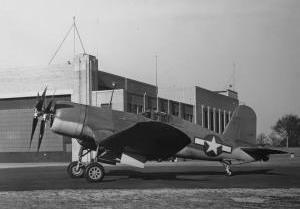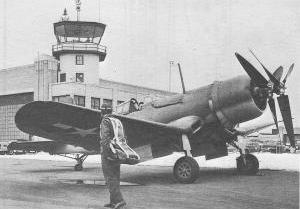


Hamilton Standard Super-Hydromatic Propellers
Part 3: Aircraft Applications
by Tom Fey
Published 11 Jun 2018; Revised 27 Oct 2023
Douglas B-23 Test Mule – Pratt & Whitney acquired a Douglas B-23 Dragon, AAF serial 39-32, to use as a test mule for various R-2800 engines, including an R-2800-S and R-2800-27 with a dual rotation nose case for testing Model 624060-1 Super-Hydromatic propellers. The date and photographs, as well as the -1 designation of the prop, indicates this is an early version of the dual rotation propeller (Fig. 23).
Chance Vought F4U-1A Corsair – A bird cage F4U-1A Corsair was fitted with an unspecified version of the R-2800 with a dual rotation nose case for testing of the Model 624060 Super-Hydromatic propeller. Cables can be seen running from the engine accessory compartment over the fuselage back into the cockpit area. It appears this aircraft tested the early version of the dual rotation Super-Hydromatic. Flight test dates are not known, but likely sometime in 1944 (Figs. 24, 25).
Douglas XTB2D-1 Skypirate – Two prototypes of the Douglas XTB2D experimental torpedo bomber were built, serial numbers 36933 and 36934. The maiden flight occurred March 13, 1945. The aircraft used the R-4360-8 engine of 3,000 horsepower with a 0.425:1 reduction ratio and SAE #60 and #80 propeller shafts. The propeller had dual four-blade hubs with the fore blades being Drawing Number 2C15 B1-12 of 14' 1" diameter and aft blades 2C15B2-12 of 14' 3" diameter. This aircraft used the "late" version of the Super-Hydromatic with the barrel-shaped pump bodies. Final disposition of the two aircraft is unknown, but there is a photograph taken 3-Dec-48 of the intact but propeller-less -934 being hoisted aboard a barge (Figs. 26, 27, 28).
Northrop XB-35 – The maiden flight of the XB-35 took place on June 25, 1946. Only 19 flights total were undertaken with the Model 828060 dual rotation Super-Hydromatic propellers due to chronic problem with failure to govern, hunting around a specific setting, and severe vibrational issues. The engines, propellers, and gearboxes were Government Furnished Equipment and were never adequately tested together before installation in the airframe. Single rotation Hydromatic propellers of 15' 3" diameter were subsequently installed to allow flight testing to continue. The first prototype flew only 24 total hours, and second prototype three hours, over three years of testing. Super-Hydromatic fore propeller blades were Drawing Number 2C15-B2-Oa7 on a #80 spline hub with a diameter of 15' 3". Aft propeller blades were Drawing Number 2C15-B2-Oa8 on a #60 spline hub with a diameter of 15' 1" with capability for both feathering and reverse pitch operation. Photographs indicate both "early" and "late" type Super-Hydromatics were installed and that six blade units, very likely of fixed pitch (both props in the pair are devoid of pump bodies) were installed, at separate times, on the outboard #1 or #4 positions on the aircraft (Figs. 29, 30, 31).
Grumman F6F-5 and Chance Vought F4U-1 – Accelerated flight tests using a single rotation Model 4260-3 Super-Hydromatic propeller were underway on both aircraft before February 1946. Propeller performance was deemed "quite satisfactory", however recurrent hydraulic fluid loss from the propeller to the engine nose case was noted, stopping testing until a seal could be designed and installed.
P-47M 42-27386 – Flight testing of a four blade, single rotation Super-Hydromatic Model 4260-25 with blades Drawing Number Y2C15B3- 30R by Paul Burke commenced on Tuesday March 12 and was completed Friday March 15, 1946. The propeller accumulated 4 hours and 35 minutes of flight time and propeller performance was deemed "satisfactory…. with a decrease in vibration"
Hughes XF-11 – The first Hughes XF-11 (44-70155) experimental photo reconnaissance aircraft utilized two Pratt & Whitney R-4360-31 turbo supercharged engines of 3,000 horsepower with dual rotation Super-Hydromatic propellers of 15' 1" diameter for the fore propeller and 15' 3" for the aft propeller. Its first and last flight occurred on July 7, 1946 with Hughes at the controls. A faulty seal in the aft propeller on the starboard Super-Hydromatic allowed hydraulic fluid to escape from the aft pump body into the engine. The uncontrolled aft blade set went into flat pitch. The resulting extreme net drag and complete thrust loss of the starboard propellers, coupled with pilot error, resulted in a near fatal crash (Figs. 32, 33, 34).
Curtiss XC-113 (maybe) – The XC-113 was a Curtiss C-46 Commando modified in 1945 and was used as a test bed for the General Electric TG-100 turboprop engine on the starboard wing. A ground accident prevented the aircraft from ever flying with the TG-100, and it is unknown if the XC-113 used the Super-Hydromatic propeller or not. Based on the XP-81, the TG-100 likely required a "self-contained" type (no oil lines in the bore of the prop shaft) propeller like the Aeroproducts or Hamilton Standard Super-Hydromatic type, however testing both a new engine and new propeller on the XC-113 would have carried significant risk (Fig. 35).
Kaiser Fleetwings XBTK-1 – The XBTK-1 was designed as a "Skyraider-light" single place dive bomber/scout aircraft intended to operate off the smaller CVE class aircraft carriers. First flown in April 1945 and powered by a Pratt & Whitney R-2800 with the Hamilton Standard Super-Hydromatic, it several novel airframe features. Problems with governing and surging of the 13’7” diameter Super-Hydromatic prop (with 2C15B1-16N blades) required retrofitting a Hamilton Standard Hydromatic of equivalent diameter to continue flight testing. Two prototypes were built and flown, and perhaps three additional airframes were produced, but the contract was terminated in September 1946 with both flying aircraft struck off inventory by April 1948.
Convair XP-81 – The second iteration of the dual powered XP-81 was the first American turboprop to fly using a 1,400 horsepower General Electric TG-100 (XT31) turboprop engine with a single rotation propeller in the nose and a 3,750 lb-thrust Allison J33-GE-35 jet engine in the aft fuselage. First flight of this power plant combination was December 21, 1945. The aircraft used a four blade Aeroproducts A542F-17 prop of 12’ 1” diameter on the early flights, however later test work on aircraft 44-91001 used a 12’ 6” diameter Hamilton Standard Super-Hydromatic with "… square tips and suffered vibration and oil leakage problems." The vibration was traced to a dynamic imbalance issue that was corrected by adding 98 inch-ounces of static imbalance to the propeller. Interestingly, the Super-Hydromatic’s 35 degree per second pitch change caused the propeller control system to overshoot the desired pitch setting, resulting in oscillatory hunting in pitch and wild excursions in torque horsepower. Ultimately a restrictor valve was put in the control system that reduced the pitch change rate to a more manageable 5 degrees per second.
Ryan XF2R-1 Dark Shark – The experimental, dual powered Ryan XF2R-1 was pulled by 1,760 horsepower General Electric TG-100 (T31) turboprop engine with a 11 foot diameter Super-Hydromatic single rotation propeller in the nose and pushed by a 1,650 lb. thrust General Electric I-16 jet engine in the aft fuselage. First flight was in November of 1946 and top speed neared 500 mph. Flight test involving flattening of prop pitch on approach and after landing to minimize landing runs were successfully performed (Figs. 38, 39, 40).
Lockheed (L-1249) U.S. Navy R7V-2 and U.S. Air Force YC-121F – Both were powered by Pratt & Whitney T34 turboshaft engines of 5,500 horsepower each, which propelled the aircraft to a cruise speed of 430 mph. The propellers used on these aircraft were the three-blade, square-tipped, 15 foot diameter Hamilton Standard Model A-3470-5. The A-3470 was used exclusively on the turbine Constellations and sported a presumably steel blade with a 24 inch chord. The blade drawing number is "A4D15A3-24H CHG. M". Based on the similarity of Figure 41 to the "Turbo-Hydromatic" propeller mounted on a test cell T34 in the 1953 Hamilton Standard Family Day brochure (Part 1, Figs. 45 and 46), plus the service annotation that cracks were found in the pump bodies of the propellers while in service, leads me to believe that the A-3470-5 propeller is indeed of the Super-Hydromatic design. If this is true the A-3470 series Super-Hydromatic propellers flew approximately 4,500 hours in the USAF YC-121F aircraft in addition to whatever hours were flown in the two USN R7V-2 aircraft.